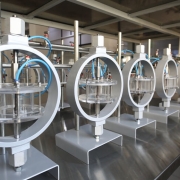NACE TM0177 vs NACE TM0284: A Comprehensive Understanding
Introduction
Understanding the nuances of different testing methods is crucial when dealing with materials for oil and gas applications. Two prominent standards, NACE TM0177 and NACE TM0284, are frequently referenced in the industry. While both are vital for assessing materials’ resistance to hydrogen embrittlement and cracking in corrosive environments, they differ in scope, application, methodology, cost, and testing time. This guide will explore these differences, providing insights to help you make informed decisions in material selection and testing.
What Are NACE TM0177 vs NACE TM0284?
NACE TM0177
NACE TM0177, titled “Laboratory Testing of Metals for Resistance to Sulfide Stress Cracking and Stress Corrosion Cracking in H2S Environments,” is a standard that outlines four different methods (A, B, C, and D) to test metallic materials’ susceptibility to sulfide stress cracking (SSC). These methods simulate the conditions metals might face in sour environments, particularly those containing hydrogen sulfide (H2S).
Method A: Tensile Test in H2S
Method B: Bent-Beam Test in H2S
Method C: C-Ring Test in H2S
Method D: Double-Cantilever Beam (DCB) Test
Each method is designed to replicate different stress and environmental conditions, comprehensively assessing a material’s behavior in sour environments.
NACE TM0284
NACE TM0284, known as the “Evaluation of Pipeline and Pressure Vessel Steels for Resistance to Hydrogen-Induced Cracking,” focuses on testing steel’s resistance to hydrogen-induced cracking (HIC). This standard is particularly relevant for pipeline and pressure vessel steels exposed to wet H2S environments, where hydrogen can be absorbed into the steel, leading to internal cracking.
Plate Testing: The test involves exposing steel samples to a controlled sour environment and sectioning them to examine for cracks.
NACE TM0284 is typically used for evaluating carbon and low-alloy steels, providing an essential criterion for materials used in pipelines, pressure vessels, and other critical applications.
Key Differences: NACE TM0177 vs NACE TM0284
Scope of Application
NACE TM0177: Applicable to a broader range of metals and alloys, focusing on resistance to sulfide stress cracking.
NACE TM0284: Specifically designed for evaluating hydrogen-induced cracking in pipeline and pressure vessel steels.
Testing Methods
NACE TM0177: Involves multiple methods, including tensile, bent-beam, C-ring, and double-cantilever beam tests to assess SSC susceptibility.
NACE TM0284: Focuses on plate testing to evaluate HIC in steel samples.
Type of Corrosion
NACE TM0177: Primarily addresses sulfide stress cracking (SSC) and stress corrosion cracking (SCC).
NACE TM0284: Concentrates on hydrogen-induced cracking (HIC).
Material Focus
NACE TM0177: Suitable for various materials, including carbon steels, low-alloy steels, stainless steels, and nickel-based alloys.
NACE TM0284: Mainly applied to carbon and low-alloy steels used in pipelines and pressure vessels.
Cost and Testing Time
NACE TM0177:
Cost: Typically ranges from $5,000 to $15,000 per test, depending on the method used and the complexity of the test setup. Method A (Tensile Test) is generally less expensive, while Method D (Double-Cantilever Beam) tends to be more costly due to the specialized equipment required.
Testing Time: This can take anywhere from 2 weeks to 3 months, depending on the method and the specific conditions under which the test is conducted. Method B (Bent-Beam Test) and Method C (C-Ring Test) tend to be faster, while Method D might take longer.
NACE TM0284:
Cost: Generally ranges from $7,000 to $20,000 per test. The price can vary based on the sample size, the number of samples tested, and the conditions of the sour environment used during the test.
Testing Time: Typically takes 4 to 6 weeks, including sample preparation, exposure, and subsequent evaluation for cracks. The time may be extended if multiple samples are tested or the environmental conditions are more aggressive.
Practical Applications and Considerations
When to Use NACE TM0177
NACE TM0177 is best utilized when selecting materials for sour service environments, particularly in upstream oil and gas operations where H2S is prevalent. The standard is crucial for assessing the SSC resistance of materials in downhole tubing, casing, and other critical components exposed to sour gas.
Example Scenario: Selecting a material for a downhole tubing application where the presence of H2S could lead to sulfide stress cracking. NACE TM0177 testing would help ensure the chosen material can withstand these conditions.
When to Use NACE TM0284
NACE TM0284 is indispensable for evaluating pipeline and pressure vessel steels in environments where H2S is present, and HIC is a concern. This standard is often applied in midstream and downstream operations, where pipelines and pressure vessels are exposed to wet sour gas.
Example Scenario: Assessing the suitability of a carbon steel pipeline material that will transport sour gas over long distances. NACE TM0284 testing ensures the material is resistant to hydrogen-induced cracking, thereby preventing potential failures.
Choosing the Right Standard: Factors to Consider
When deciding between NACE TM0177 and NACE TM0284, consider the following factors:
Material Composition: Is the material a carbon steel, low-alloy steel, or a more specialized alloy?
Service Environment: Will the material be exposed to dry or wet H2S? What is the concentration of H2S?
Type of Corrosion Concern: Are you more concerned about sulfide stress cracking or hydrogen-induced cracking?
Component Type: Is the material intended for use in pipelines, pressure vessels, or other critical infrastructure?
Budget and Time Constraints: How much will you spend on testing, and what are your project deadlines?
Conclusion: Integrating NACE Standards into Your Material Selection Process
NACE TM0177 and NACE TM0284 are vital standards for ensuring the integrity of materials used in corrosive environments, particularly those containing hydrogen sulfide. By understanding each standard’s specific focus, cost, and time requirements, you can make informed decisions that enhance the safety and reliability of your operations.
Whether selecting materials for sour service applications or ensuring pipeline integrity, these standards provide the necessary framework to evaluate and mitigate risks associated with SSC and HIC. Integrating these standards into your material selection and testing processes will help safeguard your assets and ensure long-term operational success.


